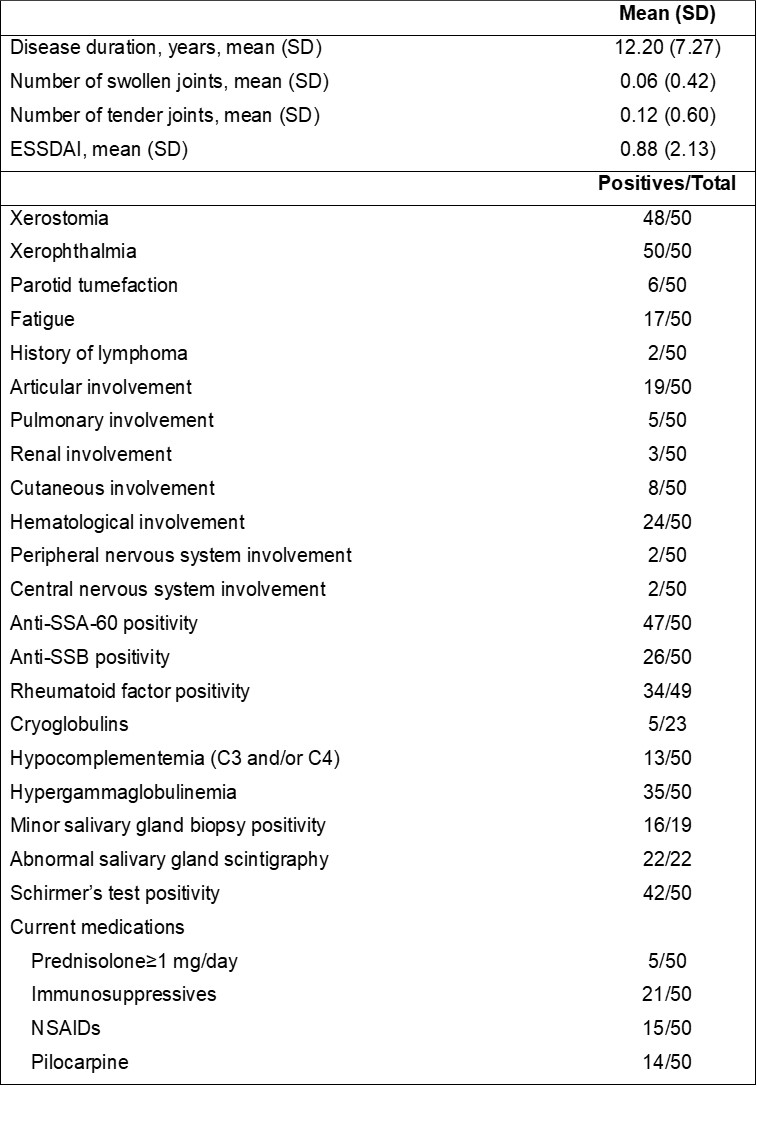Session Information
Session Type: Poster Session A
Session Time: 8:30AM-10:30AM
Background/Purpose: Salivary-gland ultrasound has recently shown to help in the diagnosis and monitoring of primary Sjögren’s syndrome (pSS)1. Shear-wave elastography (SWE) is a promising tool for the quantitative assessment of tissue stiffness2. However, studies evaluating its role in ultrasound evaluation of pSS are still limited. This study aimed to investigate the diagnostic performance of SWE in pSS and its correlation with B-mode findings.
Methods: Cross-sectional study including consecutive patients fulfilling the ACR/EULAR 2016 classification criteria for pSS, followed at our Rheumatology clinic, and age and gender-matched healthy controls. A protocolized clinical and ultrasound evaluation was performed for each patient. The four major salivary glands (parotid and submandibular glands, bilaterally) were assessed by SWE and B-mode modalities by 2 and 3 independent operators, respectively, blinded to the diagnosis. B-mode scans were rated using the Hocevar score3, and mean shear-wave velocity (SWV) values were obtained from 6 different measures for each gland. Student’s t-test, chi-square test and Pearson’s correlation were performed to compare data, as appropriate. Inter and intra-rater reliability were calculated using intraclass-correlation coefficient (ICC). Cut-off values for differentiating pSS patients from controls were calculated using Receiver-Operating Characteristics (ROC) curves.
Results: We included 50 pSS patients (mean (SD) age 56.2 (13.7); 98.0% females) and 25 controls (mean (SD) age 53.5 (9.2); 96.0% females) (Table 1). For SWE and B-mode modalities, inter-rater reliability was moderate to good (ICC: 0.64 and ICC:0.78-0.95, respectively), while intra-rater reliability was good to excellent (ICC:0.74-0.83 and ICC:0.95-0.98, respectively). Hocevar scores were higher in pSS patients than in controls (p< 0.001) in all four glands examined (Table 2). The mean total SWV (2.09 m/s (0.32); p< 0.001), mean parotid SWV (2.25 m/s (0.53)) and mean submandibular SWV values (1.86 m/s (0.36)) were significantly higher in patients than in controls. No significant correlation between Hocevar scores and SWV values was observed. The cut-offs of 1.95 m/s, 1.96 m/s and 1.60 m/s for total, parotid and submandibular SWV values differentiated pSS patients from controls with sensitivity of 65.3%, 77.6% and 79.2% and specificity of 80.0%, 68.0% and 64.0%, respectively. The area under the ROC curve (AUROC) was not significantly different between total SWV (AUROC=0.78) and parotid SWV (AUROC=0.81), p=0.696. Both were significantly greater than AUROC for submandibular SWV (AUROC=0.68), p< 0.05 (Figure 1).
Conclusion: SWE may represent a relevant additional tool for the diagnosis of pSS. SWV values did not correlate with B-mode, probably due to the difficulty in scoring severely fibrotic glands using Hocevar score. Larger studies including patients with pSS and patients with sicca syndrome, as well as standardization of SWE protocols, are warranted to assess the role of SWE in the diagnostic algorithm of pSS.
References: 1. Ramsubeik K et al. Ther Adv Musculoskelet Dis. 2020; 12:1-21 2. Santiago T et al. Clin Exp Rheumatol. 2016; Sep-Oct;34 Suppl 100(5):137-141 3. Hocevar A et al. Eur J Radiol. 2007;Sep;63(3):379-83.
To cite this abstract in AMA style:
Prata A, Freitas J, Marques M, Costa F, Santiago M, Serra S, Coutinho M, Santiago T, Lopes Rovisco J, Pereira da Silva J. Shear-Wave Elastography Evaluation of Major Salivary Glands and Correlation with B-mode Findings in Patients with Primary Sjögren’s Syndrome [abstract]. Arthritis Rheumatol. 2021; 73 (suppl 9). https://acrabstracts.org/abstract/shear-wave-elastography-evaluation-of-major-salivary-glands-and-correlation-with-b-mode-findings-in-patients-with-primary-sjogrens-syndrome/. Accessed .« Back to ACR Convergence 2021
ACR Meeting Abstracts - https://acrabstracts.org/abstract/shear-wave-elastography-evaluation-of-major-salivary-glands-and-correlation-with-b-mode-findings-in-patients-with-primary-sjogrens-syndrome/



